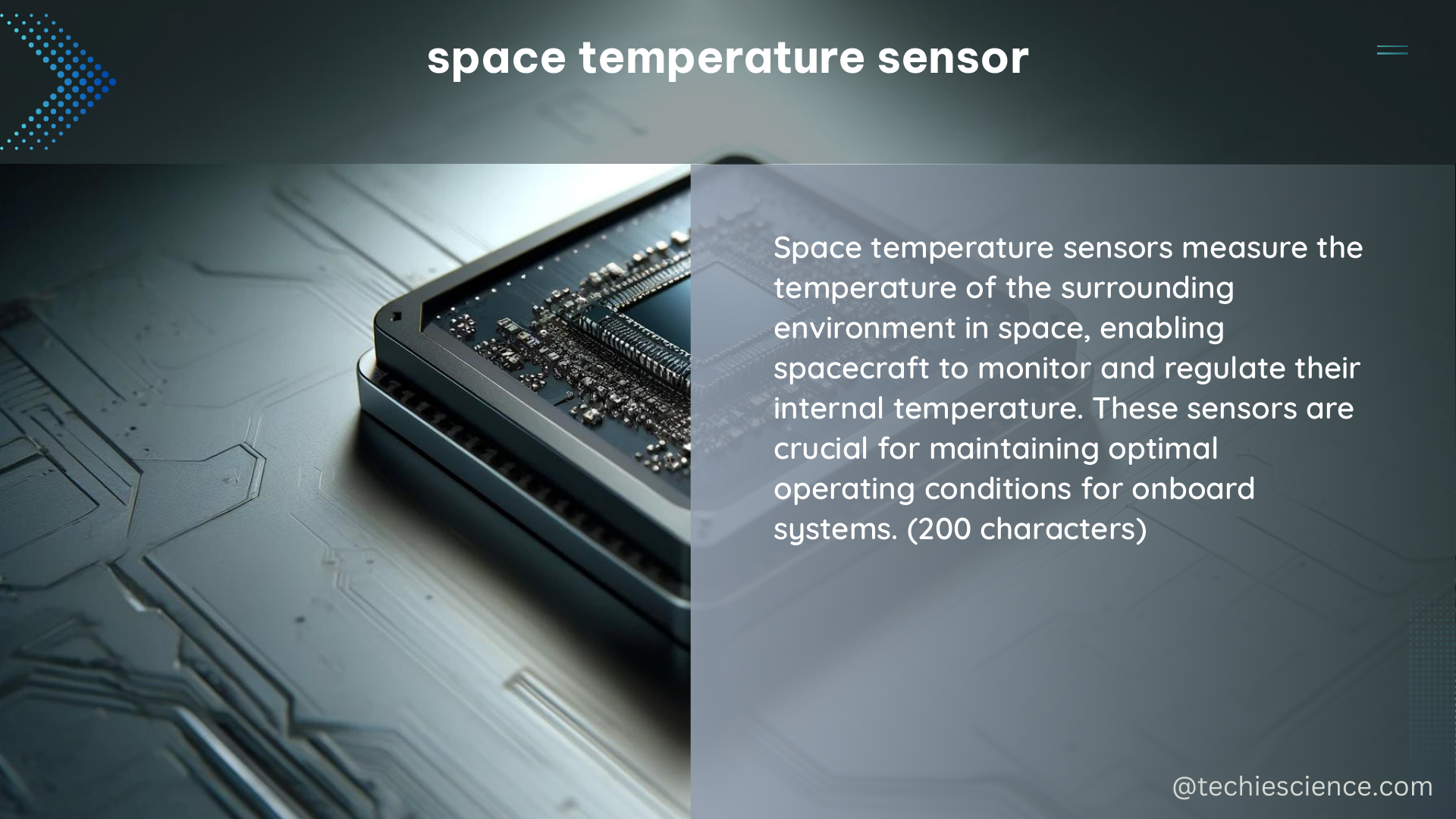Space temperature sensors are crucial components in various systems, including Building Automation Systems (BAS) and HVAC systems, to ensure proper temperature control in space environments. These sensors are designed to measure temperature in space and provide accurate data for further processing and control.
Technical Specifications of Space Temperature Sensors
Sensing Range
Space temperature sensors typically have a sensing range of -100°C to +200°C, allowing them to measure temperature in a wide range of space environments, from cryogenic temperatures in deep space to the extreme heat of re-entry. This wide sensing range is achieved through the use of specialized sensor materials and advanced signal conditioning circuitry.
Accuracy
The accuracy of space temperature sensors can vary, but high-quality sensors can achieve an accuracy of ±0.1°C to ±1°C, depending on the sensor type and manufacturer. This level of accuracy is essential for critical applications, such as monitoring the temperature of sensitive scientific instruments or ensuring the proper functioning of life support systems in manned spacecraft.
Response Time
The response time of space temperature sensors is crucial for accurate temperature measurement, especially in dynamic space environments. High-quality sensors can have a response time of less than 1 second, ensuring rapid and accurate temperature measurement. This is achieved through the use of thin-film sensing elements and advanced thermal management techniques.
Output Signal
Space temperature sensors can provide a variety of output signals, including analog (0-10V, 4-20mA), digital (I2C, SPI, UART), and even wireless (Bluetooth, Wi-Fi) communication. The choice of output signal depends on the specific application requirements, such as the need for long-distance data transmission or integration with existing control systems.
Environmental Durability
Space temperature sensors are designed to withstand the harsh environments of space, including extreme temperatures, vibrations, and radiation. High-quality sensors can have an operating temperature range of -200°C to +300°C and can withstand vibrations up to 50g. They are also designed to be resistant to the effects of ionizing radiation, which can degrade the performance of electronic components over time.
Advanced Space Temperature Sensor Technologies

Fiber Optic Temperature Sensors
Fiber optic temperature sensors are becoming increasingly popular in space applications due to their immunity to electromagnetic interference, small size, and ability to withstand high levels of radiation. These sensors use the temperature-dependent properties of optical fibers to measure temperature, with the ability to provide distributed temperature measurements along the length of the fiber.
Quantum Dot Temperature Sensors
Quantum dot temperature sensors are a novel technology that leverages the unique properties of quantum dots to provide highly accurate and fast temperature measurements. These sensors can achieve an accuracy of ±0.01°C and a response time of less than 10 milliseconds, making them ideal for applications that require rapid temperature monitoring, such as in-situ thermal management of spacecraft components.
Wireless Temperature Sensors
Wireless temperature sensors are becoming increasingly popular in space applications, as they eliminate the need for physical wiring and can be easily integrated into complex systems. These sensors use a variety of wireless communication protocols, such as Bluetooth, Wi-Fi, or proprietary radio frequency (RF) protocols, to transmit temperature data to a central control system.
DIY Space Temperature Sensor
Building a DIY space temperature sensor can be a challenging but rewarding project. Here are the steps to build a simple space temperature sensor:
- Select a Temperature Sensor: Choose a temperature sensor with a wide sensing range and high accuracy, such as the Maxim Integrated DS18B20 or Texas Instruments LM35 temperature sensor.
- Connect the Sensor to a Microcontroller: Connect the temperature sensor to a microcontroller, such as an Arduino or Raspberry Pi, using a digital input/output (I/O) pin.
- Power the Sensor: Power the temperature sensor using the microcontroller’s power supply or an external power source, ensuring that the sensor is properly grounded to prevent electrical interference.
- Program the Microcontroller: Write a program to read the temperature data from the sensor and output it in a user-friendly format, such as degrees Celsius or Fahrenheit. This may involve implementing digital communication protocols, such as I2C or 1-Wire, to interface with the sensor.
- Encapsulate the Sensor: Encase the temperature sensor and microcontroller in a protective housing to shield them from the harsh space environment, including temperature extremes, vibrations, and radiation.
- Test the Sensor: Test the sensor in a controlled environment, such as a thermal chamber, to ensure accurate temperature measurement and validate the sensor’s performance under simulated space conditions.
By following these steps, you can create a DIY space temperature sensor that can be used for a variety of applications, from monitoring the temperature of scientific experiments to providing critical data for spacecraft thermal management systems.
Conclusion
Space temperature sensors are essential components in a wide range of space-based applications, from satellite systems to manned spacecraft. By understanding the technical specifications and advanced technologies behind these sensors, you can design and build your own DIY space temperature sensor, opening up new possibilities for space exploration and research.
References
- Retro-Commissioning Process Manual, CFM, VA, 2014-06-01, https://www.cfm.va.gov/til/Cx-RCx/RetroCxManual.PDF
- Coming to Our Senses: The Future of Sensors | SAP Insights, SAP, https://www.sap.com/insights/viewpoints/coming-to-our-senses-the-future-of-sensors.html
- Laboratory Key Performance Indicators (KPIs) – BioSistemika, BioSistemika, https://biosistemika.com/blog/laboratory-key-performance-indicators-kpis/
- Sensors for daily life: A review, ScienceDirect, https://www.sciencedirect.com/science/article/pii/S2666351121000425
- DIY Temperature Sensor, Instructables, https://www.instructables.com/DIY-Temperature-Sensor/

The lambdageeks.com Core SME Team is a group of experienced subject matter experts from diverse scientific and technical fields including Physics, Chemistry, Technology,Electronics & Electrical Engineering, Automotive, Mechanical Engineering. Our team collaborates to create high-quality, well-researched articles on a wide range of science and technology topics for the lambdageeks.com website.
All Our Senior SME are having more than 7 Years of experience in the respective fields . They are either Working Industry Professionals or assocaited With different Universities. Refer Our Authors Page to get to know About our Core SMEs.